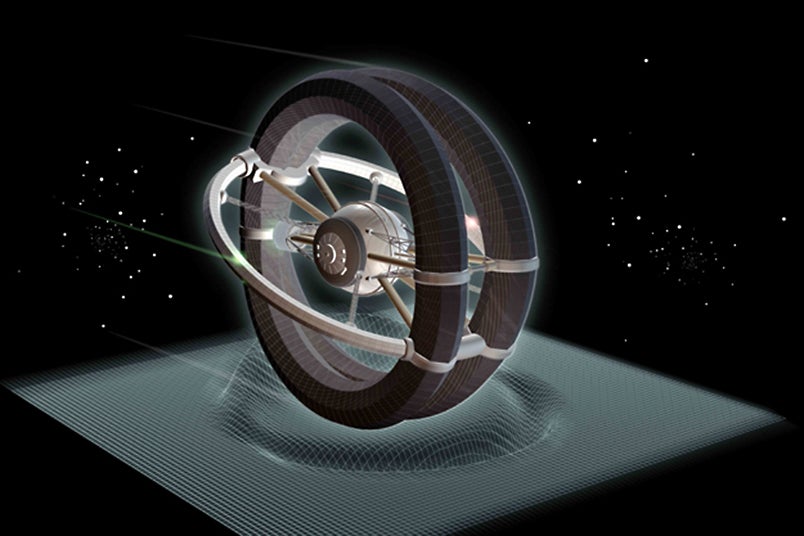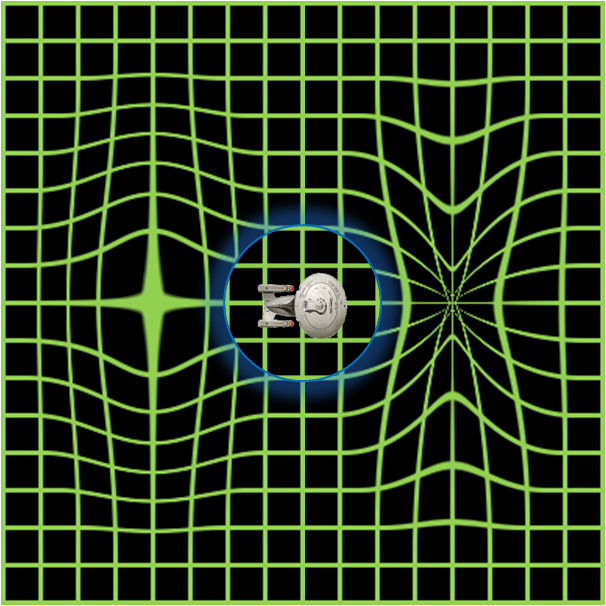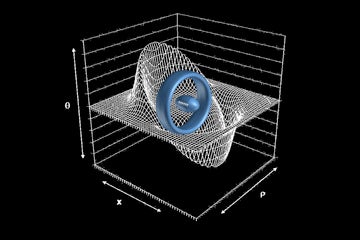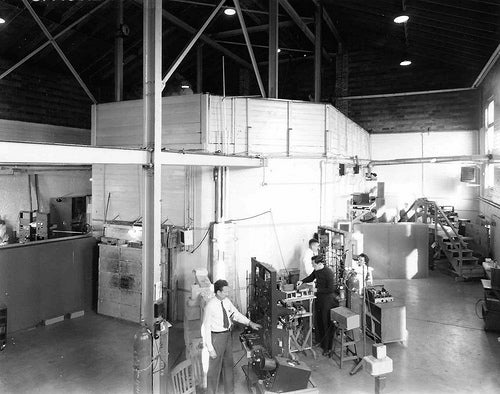Согласно Википедии:
Пузырь Алькубьерре — идея, основанная на верном решении уравнений Эйнштейна, предложенная мексиканским физиком-теоретиком Мигелем Алькубьерре, в которой космический аппарат может достичь сверхсветовой скорости. Движение выше скорости света невозможно для объектов в нормальном пространстве-времени. Однако вместо перемещения выше скорости света в пределах локальной системы координат космический корабль может двигаться, сжимая пространство перед собой и расширяя его позади, что позволяет ему фактически перемещаться с любой скоростью, в том числе быстрее света. Таким образом, корабль движется в гипер-релятивистском локально-динамическом пространстве. В 1994 году Алькубьерре предложил метод изменения геометрии пространства посредством создания волны, сжимающей пространство впереди и расширяющей его сзади
http://www.youtube.com/watch?v=9M8yht_ofHc#t=2574
Although the metric proposed by Alcubierre is mathematically valid in that it is consistent with the Einstein field equations, it may not be physically meaningful or indicate that such a drive could be constructed. The proposed mechanism of the Alcubierre drive implies a negative energy density and therefore requires exotic matter, so if exotic matter with the correct properties does not exist then it could not be constructed. However, at the close of his original paper Alcubierre argued (following an argument developed by physicists analyzing traversable wormholes) that the Casimir vacuum between parallel plates could fulfill the negative-energy requirement for the Alcubierre drive. Another possible issue is that although the Alcubierre metric is consistent with general relativity, general relativity does not incorporate quantum mechanics, and some physicists have presented arguments to suggest that a theory of quantum gravity which merged the two theories would eliminate those solutions in general relativity which allow for backwards time travel (see the chronology protection conjecture), of which the Alcubierre drive is one.
It was thought to use too much negative energy until Harold Sonny White said that the amount of energy could be reduced if you changed the warp bubble into a warp ring.
Другая проблема состоит в необходимости создания для такого двигателя областей пространства с отрицательной плотностью энергии — соответственно заполненных «экзотической материей». На сегодняшний день экспериментально подтвержден только один пример такой субстанции — это вакуум Казимира, получение которого в макроскопических масштабах для создания двигателя Алькубьерре было рассмотрено Чарльзом Риджли
In 2012, a NASA laboratory announced that they have constructed an interferometer that they claim will detect the spatial distortions produced by the expanding and contracting spacetime of the Alcubierre metric. The work has been described in Warp Field Mechanics 101, a NASA paper by Harold Sonny White. Alcubierre has expressed skepticism about the experiment, saying "from my understanding there is no way it can be done, probably not for centuries if at all". Results have been reported as "inconclusive".

 SEXPAND
SEXPAND
 SEXPAND
SEXPAND
 SEXPAND
SEXPAND
 SEXPAND
SEXPAND

Пузырь Алькубьерре — идея, основанная на верном решении уравнений Эйнштейна, предложенная мексиканским физиком-теоретиком Мигелем Алькубьерре, в которой космический аппарат может достичь сверхсветовой скорости. Движение выше скорости света невозможно для объектов в нормальном пространстве-времени. Однако вместо перемещения выше скорости света в пределах локальной системы координат космический корабль может двигаться, сжимая пространство перед собой и расширяя его позади, что позволяет ему фактически перемещаться с любой скоростью, в том числе быстрее света. Таким образом, корабль движется в гипер-релятивистском локально-динамическом пространстве. В 1994 году Алькубьерре предложил метод изменения геометрии пространства посредством создания волны, сжимающей пространство впереди и расширяющей его сзади
http://www.youtube.com/watch?v=9M8yht_ofHc#t=2574
Although the metric proposed by Alcubierre is mathematically valid in that it is consistent with the Einstein field equations, it may not be physically meaningful or indicate that such a drive could be constructed. The proposed mechanism of the Alcubierre drive implies a negative energy density and therefore requires exotic matter, so if exotic matter with the correct properties does not exist then it could not be constructed. However, at the close of his original paper Alcubierre argued (following an argument developed by physicists analyzing traversable wormholes) that the Casimir vacuum between parallel plates could fulfill the negative-energy requirement for the Alcubierre drive. Another possible issue is that although the Alcubierre metric is consistent with general relativity, general relativity does not incorporate quantum mechanics, and some physicists have presented arguments to suggest that a theory of quantum gravity which merged the two theories would eliminate those solutions in general relativity which allow for backwards time travel (see the chronology protection conjecture), of which the Alcubierre drive is one.
It was thought to use too much negative energy until Harold Sonny White said that the amount of energy could be reduced if you changed the warp bubble into a warp ring.
Другая проблема состоит в необходимости создания для такого двигателя областей пространства с отрицательной плотностью энергии — соответственно заполненных «экзотической материей». На сегодняшний день экспериментально подтвержден только один пример такой субстанции — это вакуум Казимира, получение которого в макроскопических масштабах для создания двигателя Алькубьерре было рассмотрено Чарльзом Риджли
In 2012, a NASA laboratory announced that they have constructed an interferometer that they claim will detect the spatial distortions produced by the expanding and contracting spacetime of the Alcubierre metric. The work has been described in Warp Field Mechanics 101, a NASA paper by Harold Sonny White. Alcubierre has expressed skepticism about the experiment, saying "from my understanding there is no way it can be done, probably not for centuries if at all". Results have been reported as "inconclusive".
A few months ago, physicist Harold White stunned the aeronautics world when he announced that he and his team at NASA had begun work on the development of a faster-than-light warp drive. His proposed design, an ingenious re-imagining of an Alcubierre Drive, may eventually result in an engine that can transport a spacecraft to the nearest star in a matter of weeks — and all without violating Einstein's law of relativity. We contacted White at NASA and asked him to explain how this real life warp drive could actually work.
The above image of a Vulcan command ship features a warp engine similar to an Alcubierre Drive. Image courtesy CBS.
The Alcubierre Drive
The idea came to White while he was considering a rather remarkable equation formulated by physicist Miguel Alcubierre. In his 1994 paper titled, "The Warp Drive: Hyper-Fast Travel Within General Relativity," Alcubierre suggested a mechanism by which space-time could be "warped" both in front of and behind a spacecraft.
 SEXPAND
SEXPAND
Michio Kaku dubbed Alcubierre's notion a "passport to the universe." It takes advantage of a quirk in the cosmological code that allows for the expansion and contraction of space-time, and could allow for hyper-fast travel between interstellar destinations. Essentially, the empty space behind a starship would be made to expand rapidly, pushing the craft in a forward direction — passengers would perceive it as movement despite the complete lack of acceleration.
White speculates that such a drive could result in "speeds" that could take a spacecraft to Alpha Centauri in a mere two weeks — even though the system is 4.3 light-years away.
 SEXPAND
SEXPAND
In terms of the engine's mechanics, a spheroid object would be placed between two regions of space-time (one expanding and one contracting). A "warp bubble" would then be generated that moves space-timearound the object, effectively repositioning it — the end result being faster-than-light travel without the spheroid (or spacecraft) having to move with respect to its local frame of reference.
"Remember, nothing locally exceeds the speed of light, but space can expand and contract at any speed," White told io9. "However, space-time is really stiff, so to create the expansion and contraction effect in a useful manner in order for us to reach interstellar destinations in reasonable time periods would require a lot of energy."
And indeed, early assessments published in the ensuing scientific literature suggested horrific amounts of energy — basically equal to the mass-energy of the planet Jupiter (what is 1.9 × 1027 kilograms or 317 Earth masses). As a result, the idea was brushed aside as being far too impractical. Even though nature allowed for a warp drive, it looked like we would never be able to build one ourselves.
"However," said White, "based on the analysis I did the last 18 months, there may be hope." The key, says White, may be in altering the geometry of the warp drive itself.
A new design
In October of last year, White was preparing for a talk he was to give for the kickoff to the 100 Year Starship project in Orlando, Florida. As he was pulling together his overview on space warp, he performed a sensitivity analysis for the field equations, more out of curiosity than anything else.
 SEXPAND
SEXPAND
"My early results suggested I had discovered something that was in the math all along," he recalled. "I suddenly realized that if you made the thickness of the negative vacuum energy ring larger — like shifting from a belt shape to a donut shape — and oscillate the warp bubble, you can greatly reduce the energy required — perhaps making the idea plausible." White had adjusted the shape of Alcubierre's ring which surrounded the spheroid from something that was a flat halo to something that was thicker and curvier.
He presented the results of his Alcubierre Drive rethink a year later at the 100 Year Starship conference in Atlanta where he highlighted his new optimization approaches — a new design that could significantly reduce the amount of exotic matter required. And in fact, White says that the warp drive could be powered by a mass that's even less than that of the Voyager 1 spacecraft.
That's a significant change in calculations to say the least. The reduction in mass from a Jupiter-sized planet to an object that weighs a mere 1,600 pounds has completely reset White's sense of plausibility — and NASA's.
Hitting the lab
Theoretical plausibility is all fine and well, of course. What White needs now is a real-world proof-of-concept. So he's hit the lab and begun work on actual experiments.
"We're utilizing a modified Michelson-Morley interferometer — that allows us to measure microscopic perturbations in space time," he said. "In our case, we're attempting to make one of the legs of the interferometer appear to be a different length when we energize our test devices." White and his colleagues are trying to simulate the tweaked Alcubierre drive in miniature by using lasers to perturb space-time by one part in 10 million.
Of course, the interferometer isn't something that NASA would bolt onto a spaceship. Rather, it's part of a larger scientific pursuit.
"Our initial test device is implementing a ring of large potential energy — what we observe as blue shifted relative to the lab frame — by utilizing a ring of ceramic capacitors that are charged to tens of thousands of volts," he told us. "We will increase the fidelity of our test devices and continue to enhance the sensitivity of the warp field interferometer — eventually using devices to directly generate negative vacuum energy."
He points out that Casimir cavities, physical forces that arise from a quantized field, may represent a viable approach.
And it's through these experiments, hopes White, that NASA can go from the theoretical to the practical.
Waiting for that "Chicago Pile" moment
Given just how fantastic this all appears, we asked White if he truly thinks a warp-generating spacecraft might someday be constructed.
"Mathematically, the field equations predict that this is possible, but it remains to be seen if we could ever reduce this to practice."
 SEXPAND
SEXPAND
What White is waiting for is existence of proof — what he's calling a "Chicago Pile" moment — a reference to a great practical example.
"In late 1942, humanity activated the first nuclear reactor in Chicago generating a whopping half Watt — not enough to power a light bulb," he said. "However, just under one year later, we activated a ~4MW reactor which is enough to power a small town. Existence proof is important."
His cautious approach notwithstanding, White did admit that a real-world warp drive could create some fascinating possibilities for space travel — and would certainly reset our sense of the vastness of the cosmos.
"This loophole in general relativity would allow us to go places really fast as measured by both Earth observers, and observers on the ship — trips measured in weeks or months as opposed to decades and centuries," he said.
But for now, pursuit of this idea is very much in science mode. "I'm not ready to discuss much beyond the math and very controlled modest approaches in the lab," he said.
Which makes complete sense to us, as well. But thanks to these preliminary efforts, White has already done much to instill a renewed sense of hope and excitement over the possibilities. Faster-than-light travel may await us yet.
Here's NASA's New Design for a Warp Drive Ship
In 2012, NASA physicist Harold White revealed that he and a team were working on a design for a faster-than-light ship. Now he's collaborated with an artist to create a new, more realistic design of what such a ship might actually look like.
Artist Mark Rademaker told io9 that he worked with White to create the updated model, which includes a sleek ship nestled at the center of two enormous rings, which create the warp bubble.
In this video, below, you can see White talking about the new design (starting at 41:54), and explaining how it fits his mathematical analysis.
Mind, do you, if a ride, I hitch?


Что сайт NASA говорит об этом?
Warp Drive, When?
So, can we do it?
When will we have Warp Drive?
Not until we get the required breakthroughs in physics.
We need visionaries to forge science into technical realities
Are you the next Faraday, Einstein, Goddard, Von Braun...?
No comments:
Post a Comment